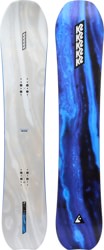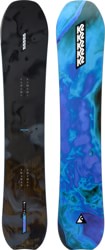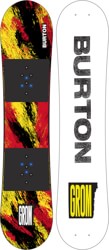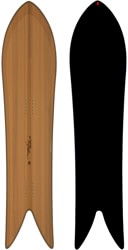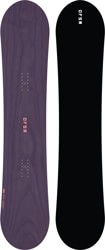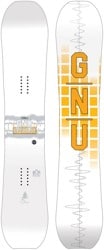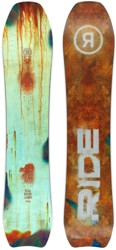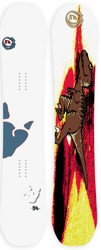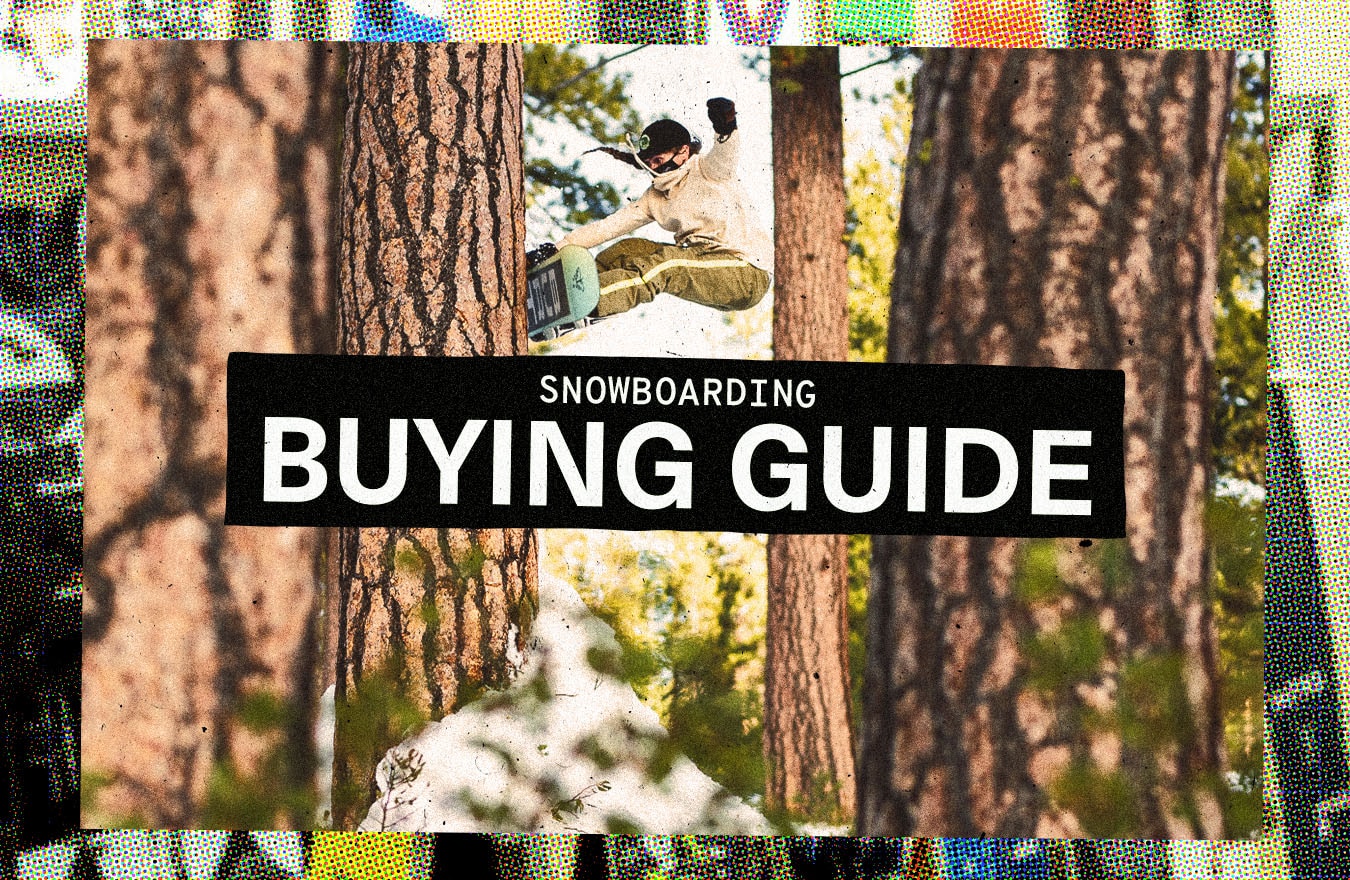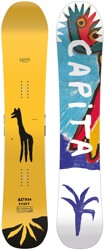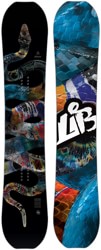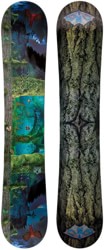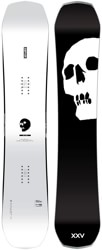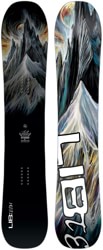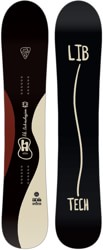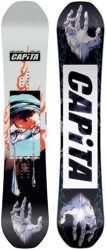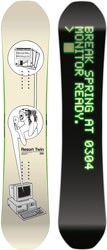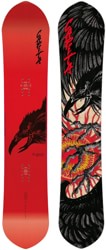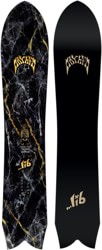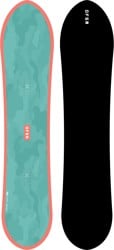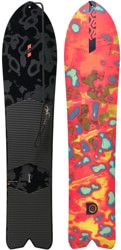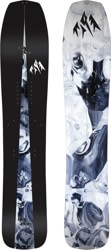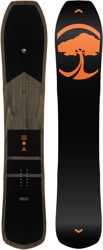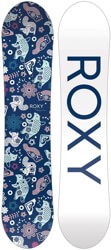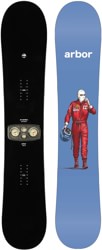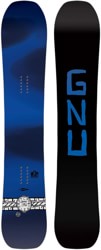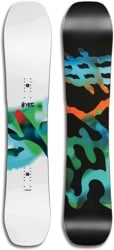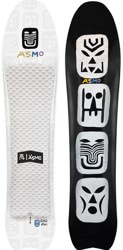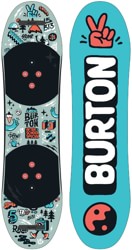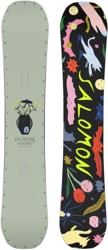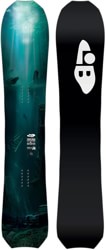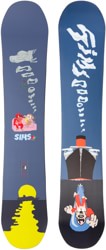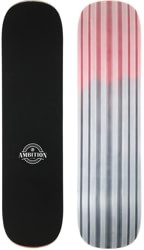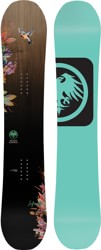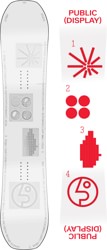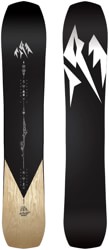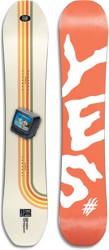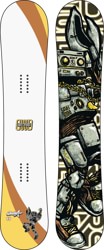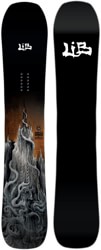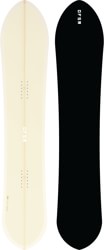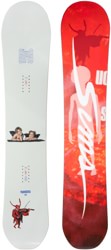Snowboard Size Chart & Buying Guide
Snowboarding is supposed to be fun but with all the options and high price tags, choosing your first board can be tough. This guide is meant to help ease the stress and teach you what you need to know in order to make your snowboard buying experience fun and get you on the hill quicker.
Here's what we'll cover:
SNOWBOARD LENGTH SIZE CHART
When picking out your board, it’s all about finding the right length for your style of riding. If you’re into park riding, shorter boards are your go-to. On the flip side, if you’re all about freeriding, longer boards offer up the edge hold, and stability, especially when tackling steeper terrain. Check-out the size chart below, It’ll give you a good idea of the snowboard length range that’ll suit you best for your time on the mountain.
| Rider Weight | All Mountain Length (CM) | Freestyle Length (CM) |
|---|---|---|
| Up To 80 lbs | 137 | 132 |
| 80-120 lbs | 140 | 135 |
| 100-130 lbs | 143 | 138 |
| 110-140 lbs | 147 | 142 |
| 125-155 lbs | 150 | 145 |
| 135-165 lbs | 153 | 148 |
| 145-170 lbs | 156 | 151 |
| 160-190 lbs | 160 | 155 |
| 175-205 lbs | 163 | 158 |
| 185-215+ lbs | 165 | 160 |

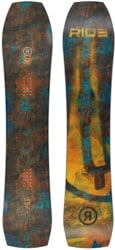
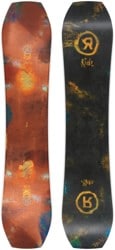
Shop All Snowboards
SNOWBOARD LENGTH
It’s important to keep your preferred riding style in mind when choosing the length of your board. Freestyle-focused riders, for example, will gravitate towards shorter board lengths to cut down on weight and make it easier to pull off tricks. They also don’t need extra edge hold or stability since they’ll mostly be riding at moderate speeds and on intermediate resort runs. On the flip side, many freeride-focused riders will want a longer board to provide more edge hold, float and stability in steeper terrain and a variety of snow conditions.
If you’re just starting out and are looking for a more All Mountain board for all-around riding, check out the size chart above to help choose the snowboard length range that’s right for you.
SNOWBOARD WIDTH
Snowboard width is an underappreciated but very important consideration. Riders with a boot size of 11+ should strongly consider looking at a wide snowboard. These boards have a wider waist width and are designed to help keep the toes and heels of big-footed shredders out of the snow when the snowboard is on edge. They can also offer a little better float in powder due to their larger surface area.
On the flip side, picking a board that is too wide for the rider’s boot size reduces the rider’s leverage over the toe and heelside edges resulting in slower, less responsive transitions from edge to edge.
TYPES OF SNOWBOARDS
The way we see it, there are three general types of snowboarding that drive the decision process in choosing a snowboard: All Mountain, Park/Freestyle, and Powder/Freeride. Just as a sports car and a 4x4 truck are both vehicles, each will perform differently depending on where and how you want to use them. Knowing the kind of riding you want to do is the first step in narrowing down the options to help focus on the best possible matches.
ALL MOUNTAIN
All Mountain snowboards are designed for the rider who needs one board to handle a wider range of ride styles and terrain. While an All Mountain board may not perform as well in deep powder as a powder specific snowboard, or handle a rail as well as a board designed specifically for the terrain park, All-Mountain snowboards will outperform more specialized niche boards when it comes to riding the entire mountain in all sorts of conditions.
All Mountain boards typically share a medium flex, allowing them to carve and hold an edge, float decently in powder, while still being playful and forgiving enough to be enjoyed in the park. They’re designed to be ridden in both directions but will tend to perform a bit better with the rider’s preferred front foot pointed downhill.



PARK / FREESTYLE
The hallmark of a terrain park snowboard is its design symmetry, meaning it will perform equally well whether riding, taking off, or landing in either direction. These boards have a soft to medium flex that allows for more expressive freestyle riding, tricks, and jibbing (e.g., nose and tail presses). They’re often built with more bomber edge and base constructions to withstand impact with rails and with less swing weight for easier spins.
If you’re focused on sliding rails, hitting jumps and turning the mountain into your own creative playground, a Park/Freestyle board is for you.

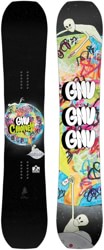
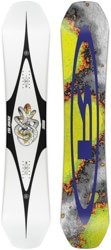
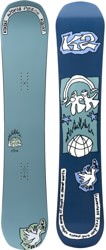
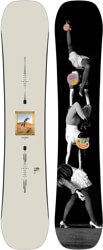
Shop Park / Freestyle Snowboards
POWDER / FREERIDE
Powder/Freeride boards excel when it comes to floating in deep snow and riding ungroomed, steep terrain. They offer a stable, smooth ride at fast speeds in a variety of snow conditions. Their firmer flex means less board chatter and improved edge hold during high-speed carves and gives you the ability to make powerful turns on the steepest terrain in variable snow conditions. Unlike more symmetrical park boards, freeride oriented snowboards are designed with distinct noses and tails and are meant to be ridden with the nose pointed forward.
Recent powder specific snowboard designs, have dramatically improved the rider’s ability to float and turn while remaining in a more balanced, natural snowboard stance. Common traits in powder boards include big noses, tapered tails, and significantly set back rider stance. Many are wide and short, retaining surface area while offering greater agility and response in the trees and other tight spots.
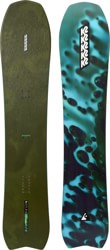
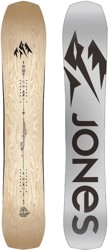
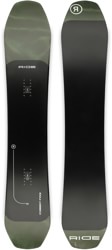
Shop Powder / Freeride Snowboards
PROFILES
The profile of your snowboard is what you see when you lay a snowboard on the ground and view it from the side at eye level. Picking the right profile for your board can seem daunting but, despite the hybrid variations and the fact each brand likes to use its own proprietary lingo to describe the same basic profile, we think virtually all snowboards can be assigned to one of three basic profile classes: camber, rocker, or flat.
When it comes to choosing your board, there is no “good” or “bad” profile. Each profile offers its own advantages and disadvantages. The most important thing to understand is how each profile type relates to different riding styles and conditions so you can choose a profile that best suits you.
CAMBER

Camber is the most traditional snowboard profile. The process of de-cambering the board (flattening out the profile arc (camber) with the rider’s weight during a turn) loads the board with energy the rider can then “release” to initiate and “snap” into the next turn. While camber boards are more prone to catching an edge and can be more unforgiving for the beginner (particularly if the board is too stiff for the rider), they offer the most powerful and energetic ride with a feel that’s hard to replicate with any other board profile.
CAMBER HYBRIDS

Beyond pure traditional camber, there are hybrid camber profiles. While the dominant profile between the rider’s feet remains cambered, these blended profiles try to incorporate some of the advantages of rocker and flat profiles towards the nose and tail of the board. Camber with rocker produces a more forgiving ride by lifting the board’s contact points off the snow. The rocker also offers better float in powder. Camber mixed with a flat profile will also be less “catchy” than traditional camber. They may not float quite as well in powder as a camber/rocker hybrid, but they retain more of the lively “pop” of camber for a playful ride that’s popular with freestyle-minded riders.
ROCKER

Rocker is the opposite of camber. Rockered snowboards move the contact points inward towards the center of the board resulting very quick and easy turn initiation that virtually eliminates the chance of catching an edge. Rocker also floats insanely well in powder but it can be squirrely at higher speeds due to reduced effective edge; that is, less board edge engaging the snow when on edge.
ROCKER HYBRIDS

Rocker hybrid profiles offer the quick, easy turn initiation of rocker but, like camber hybrids seek to also incorporate some of the benefits of camber and flat profiles into the same board. A rocker/camber hybrid typically incorporates rocker between the feet with cambered sections extending from under the rider’s feet towards the board’s contact points to bring back some of the energy and stability that’s lost in pure rocker boards. Likewise, instead of camber, some rockered hybrids incorporate flatter profiles extending out from the centered rocker section toward the nose and tail. While lacking some of the energy and stability of the rocker/camber hybrids, a rocker/flat hybrid will retain more of the catch-free playfulness of a rocker board.
FLAT

Flat profiles are the middle ground between camber and rocker. Generally, flat profiles are found on softer freestyle boards that have a focus on riding non-snow features like rails and boxes. They're also great for newbies who want a board to progress quickly on yet still enjoy riding in the future. Flat profiles offer some of the stability and edge hold of camber while allowing for a more forgiving all-around ride.
FLAT HYBRIDS

Just like Rocker and Camber profiles, Flat has a mix of hybrids. Flat with cambered sections toward the nose and tail gives a more camber-like, stable ride at speed but the flatter, typically softer section between the feet makes edge to edge transitions easier. Flat with Rocker on the other hand provides a bit more effective edge than pure Rocker so you get a little more stability at speed while retaining the catch-free, super-float ride quality that Rocker fans love.
SHAPES
The shape of a snowboard is its outline or template. Similar to profile, a board’s shape offers advantages and disadvantages for each riding style. When it comes to choosing a snowboard, an important fork in the road is deciding whether you want a board optimized to ride best with your favorite front foot forward (directional), to ride the same with either foot pointed forward (twin), or somewhere in between (directional twin). Although other design features like flex, profile, and stance position can also play roles in determining how a board performs in each direction, board shape is a primary driver.
DIRECTIONAL

Directional snowboards are designed to ride best in one direction. A typical directional shape includes a distinct nose and tail, and a progressively deeper sidecut radius towards the tail. The slightly larger nose improves float and helps the board power over and through variable snow. A progressively deeper sidecut helps “ease” the rider into a more forgiving turn while the deeper sidecut towards the tail provides energy and “snap” to help propel the board into the next turn.
Because directional snowboards are optimized to ride in one direction with the rider’s preferred front foot forward, they are not well-suited for more serious freestyle riding styles where the ability to ride, initiate tricks, and land in either direction is critical. On the other hand, for the more all-mountain, freeride, or powder-oriented rider who is perfectly happy leading with his preferred front foot virtually all the time, a directional board is the right choice.
TRUE TWIN

If directional snowboards are on one end of the board shape spectrum, twins are on the other. Twins are completely symmetrical, with identically shaped nose and tails and a perfectly circular sidecut radius deepest at the middle of the board’s length. A twin snowboard’s symmetry and balance is ideal for the true freestyle snowboarder who needs the board to perform the same in either direction.
DIRECTIONAL TWIN

If “directional” is the opposite of “twin”, what is a “directional twin”? That’s a great question and it highlights the fact that board shape is not the only design ingredient that determines how a board rides in either direction. As with the various board profile hybrids that combine rocker with camber, directional twins are an attempt to capture the benefits of different design concepts into the same board, making it suitable for a wider range of ride styles and terrain. For example, a directional twin may have a symmetrical shape but an asymmetrical flex (stiffer flex toward the tail) or have a slightly directional shape with symmetrical, twin flex. Generally speaking, directional twins are for the all-mountain rider who spends a good chunk of the day riding switch (that is, in the opposite direction of her preferred front foot).
Shop Directional Twin Snowboards
ASYMMETRICAL (ASYM)

A small but growing category of boards utilize distinct sidecuts on each edge of the same board. Referred to as “asyms”, these boards have a dedicated heelside edge designed to improve heelside turning and edge control. For the simple reason that bent knees can only point toward the toes, it is more difficult to maintain the same leverage and control over the heelside edge. Shortening and deepening the heelside sidecut helps compensate for this natural disadvantage and allows the rider to make quicker, tighter, more responsive heelside turns.
FLEX
Snowboard flex refers to the board’s torsional and lateral bend under pressure. A “softer” flex requires less pressure to initiate and hold the bend while a “stiff” board requires greater force. Unfortunately, there is no standardized flex rating system for snowboards. The majority of snowboard manufacturers use a 1-10 flex rating system (1=super soft, 10=very stiff) while others will use a proprietary system to convey the same message. We think it’s most helpful to break flex down into three classes: soft, medium, and stiff. Choosing the right flex in a snowboard depends on the rider’s experience level, size, and preferred use.
SOFT FLEX

Softer flexing boards are ideal for beginners, lighter weight riders, as well as freestylers focused on jibbing and riding terrain park features. Just as the ”loose” power steering on a big old Cadillac makes it easier to navigate a crowded parking lot, for beginners and lighter weight riders, a softer board makes it easier to flex and control the board through turns at slower speed . The ability to more easily flex the board also benefits terrain park riders focused on sliding rails and boxes, or just “buttering the muffin” with sustained nose and tail presses.
So why isn’t everyone on a soft board? Softer snowboards fall short during higher-speed, more aggressive riding. When a board isn’t beefed up to at least a medium flex, it will tend to produce excessive board chatter at higher speeds resulting in less edge hold and a loss of control.
MEDIUM FLEX

The majority of snowboards are built with a medium flex in order to accommodate the widest range of riders and uses. Heavier weight beginners, and dedicated lightweights who aren’t afraid of a few bumps on their first days on this hill, can usually tolerate a medium flexing board right out of the gate. Although not as user friendly as a soft board on the mellowest slopes at slow speed, a mid-flexing board will provide better stability and control as the rider progresses to steeper terrain and higher speeds.
STIFF FLEX

If soft boards resemble loose power steering and make for a more forgiving ride at slow speeds, they can make it downright sketchy when the pedal’s to the metal. When the terrain gets steep and gnarly, riders need the tight ride of a stiffer flexing snowboard. At high speeds in variable snow conditions, stiff boards are stable, more responsive to the rider’s slight weight adjustments, and better able to “track” the rider’s intended line. Finally, because riders come in all shapes and sizes, a stiffer board can also be a good choice for the experienced, heavy set rider whose added weight might turn a medium flexing board into a soft one.
STILL HAVE QUESTIONS?
We’re here to help. You can call, email, chat or IM during business hours seven days a week. Our staff snowboards…a lot. We're happy to help you with all things snowboarding.
LEARN MORE ABOUT SNOWBOARDING:


